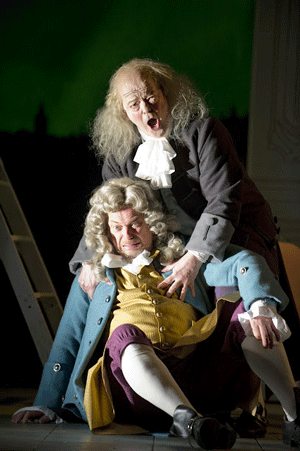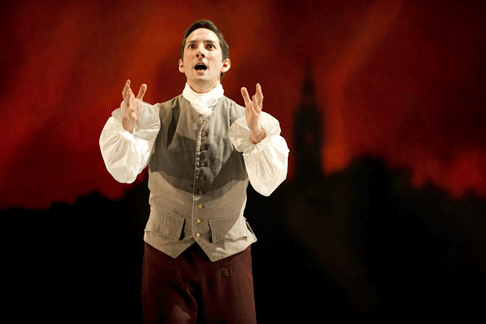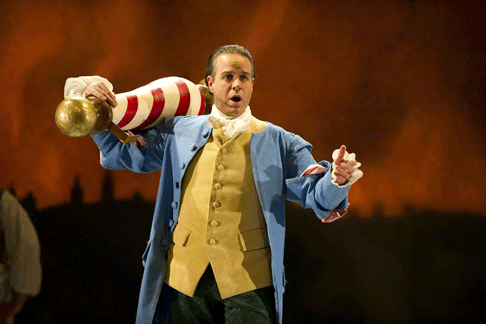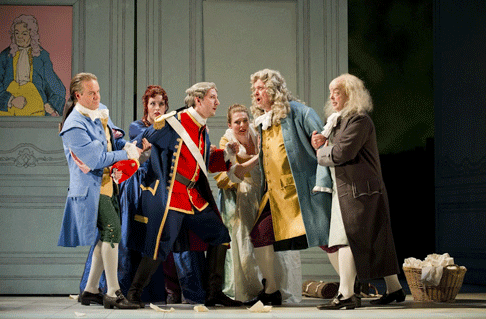12 Mar 2012
A Physical Barber by ETO
For an operatic masterpiece The Barber of Seville is surprisingly tricky to do well, it is not one of those pieces which plays itself.

For an operatic masterpiece The Barber of Seville is surprisingly tricky to do well, it is not one of those pieces which plays itself.
For a start, it is rather long with copious quantities of plot and of recitative. Essentially it’s a fast paced farce, but one which is populated by believable, human characters thanks to Rossini’s music. But then, Rossini goes and throws in those long, stylised ensembles which sound fabulous but present the director with the problem of what to do. Some solve this by making the farce veer into slapstick, and other productions just aren’t funny (on Radio 3 recently the director of the Met, Peter Gelb, talked about one of their patrons not realising that The Barber of Seville was a comedy).
 Andrew Slater as Bartolo and Alan Fairs as Basilio
Andrew Slater as Bartolo and Alan Fairs as Basilio
For ETO’s new production, which opened at the Hackney Empire on March 8th (we saw it on March 10th), director Thomas Guthrie opted for a very physical approach, but one that was strongly character based. The cast were all highly choreographed (the ensemble in the first scene actually break out into choreographed dance), but we never descended into slapstick, laughs always came because of the interaction on the stage not simply because a character was doing a funny walk. He kept the piece moving at a very fast pace and the talented, young cast responded by delivering recitative that was dramatically convincing and quick moving. The work was sung in English, in David Parry’s musical translation. The result was, as it should be, highly entertaining, you never felt that you were sitting through the recit simply waiting for the next aria, as can happen.
 Nicholas Sharratt as Almaviva
Nicholas Sharratt as Almaviva
Rhys Jarman’s traditionally inspired designs consisted of a series of painted flats representing panelling; with judicious additions in each scene, these created a flexible series of playing spaces, both interior and exterior. All overlooked by a striking backdrop of a city-scape with a lowering sky. Colours were in a carefully chosen tonal palate, modern but classical; with Gillray style cartoons in modern colours as the pictures in Bartolo’s house. Costumes were traditional too, but the piece didn’t feel embedded in aspic.
The title role was played by Grant Doyle, who studied both in his native Australia and at the RCM. He was on the ROH Young Artists programme in 2001-3 and plans include the title role in Don Giovanni at Garsington. Doyle has a strong stage presence and effortlessly dominated, as Figaro should, without ever mugging. (Incidentally he played the guitar himself during the Act 1 serenade). His Figaro was rather a smug character, almost annoyingly so, but a charmer too. His account of ‘Largo al factotum’ was marred very slightly by balance problems, which reoccurred at other times during the performance; from our seat in the Dress Circle the orchestra sometimes was a little too strong for the singers, probably more to do with the acoustic of Frank Matcham’s theatre (which was built as a music hall) than anything else.
Kitty Whately won the Kathleen Ferrier Award in 2011 and currently studies at the RCM International Opera School. We saw her as Teodata in Flavio at ETO last year and were looking forward to her singing Rosina and we were not disappointed. Whately has a poised stage presence and gave the impression that Rosina was looking on the world, for the most part, in amused tolerance. A strong minded person, but lively and certainly attractive; she was touching in the closing scenes when Rosina thinks that she has been betrayed by Figaro and ‘Lindoro’.
 Grant Doyle as Figaro
Grant Doyle as Figaro
I have to confess that when it comes to the singing of passage-work both in baroque opera and early 19th century Italian opera, I am a bit of an obsessive; in an ideal world everything should be sung beautifully and cleanly. This Whately did, of the 3 main leads (Rosina, Figaro, Almaviva) all sang their passage-work confidently, expressively and creditably. But there were times when I felt that both Nicholas Sharratt (singing Almaviva) and Doyle were smudging things, but Whately’s divisions always seemed to come out cleanly.
She was partnered by the highly personable Nicholas Sharratt who has sung Nemorino at Grange Park Opera and Brighella (Ariadne auf Naxos) at Garsington. He has an attractive, quite slim-line lyric tenor voice with an easy top so that as Count Almaviva the tessitura of the role did not seem to hold terrors for him. As I have said, there were times when I felt he smudged his passage-work, but I warmed to his performance. His open stage presence and the way he developed a good rapport with Whately were endearing; plus he had good comic timing, he was funny without ever over doing things when playing the drunken soldier. He topped this by giving a fine account of the Count’s final aria, the showpiece which is usually cut and which Rossini re-used for La Cenerentola. After a long evening, Sharratt’s performance was quite brilliant and made a good dramatic case for including the aria.
 L-R: Grant Doyle as Figaro, Kitty Whately as Rosina, Nicholas Sharratt as Almaviva, Cheryl Enever as Berta, Andrew Slater as Bartolo and Alan Fairs as Basilio
L-R: Grant Doyle as Figaro, Kitty Whately as Rosina, Nicholas Sharratt as Almaviva, Cheryl Enever as Berta, Andrew Slater as Bartolo and Alan Fairs as Basilio
Andrew Slater has been an ETO regular for a few years now. He played Doctor Bartolo as an obsessively jealous dyspeptic, rather than being plain nasty. He coped manfully with having to do some amazingly botched comic surgery on patients during his Act 1 aria; one of the few moments when Guthrie’s ideas got the better of him. As with all good comedy, you felt sorry for Bartolo even though he behaved badly.
Alan Fairs was a hilariously scary Don Basilio and gave a strong, highly characterised account of the calumny arias. Cheryl Enever was a lively Berta, unfortunately deprived of her aria.
Conductor Paul McGrath kept things going at quite a lick, which was great for the comedy but which meant that co-ordination between pit and stage was not always quite what it should have been; this was particularly true in the big comic ensembles when Guthrie has his cast moving around. But it was an understandable error, given the desire to keep everything zipping along.
This was a performance full of energy and vivid character. Guthrie’s very physical approach to theatre was enthusiastically taken up by the cast. Despite the occasional problems, this was a performance that was funny and enjoyable in all the right ways.
ETO is performing the opera on tour in the UK until May 26th, along with Eugene Onegin and three children’s operas.
Robert Hugill